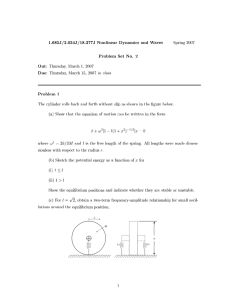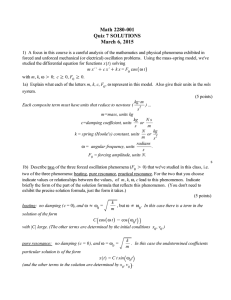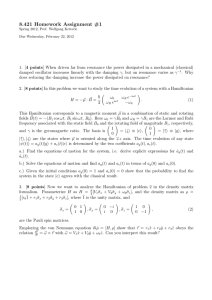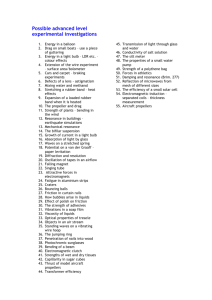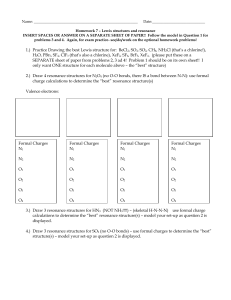Investigations on Strong Resonance in Multimachine Power Systems With STATCOM Supplementary
advertisement
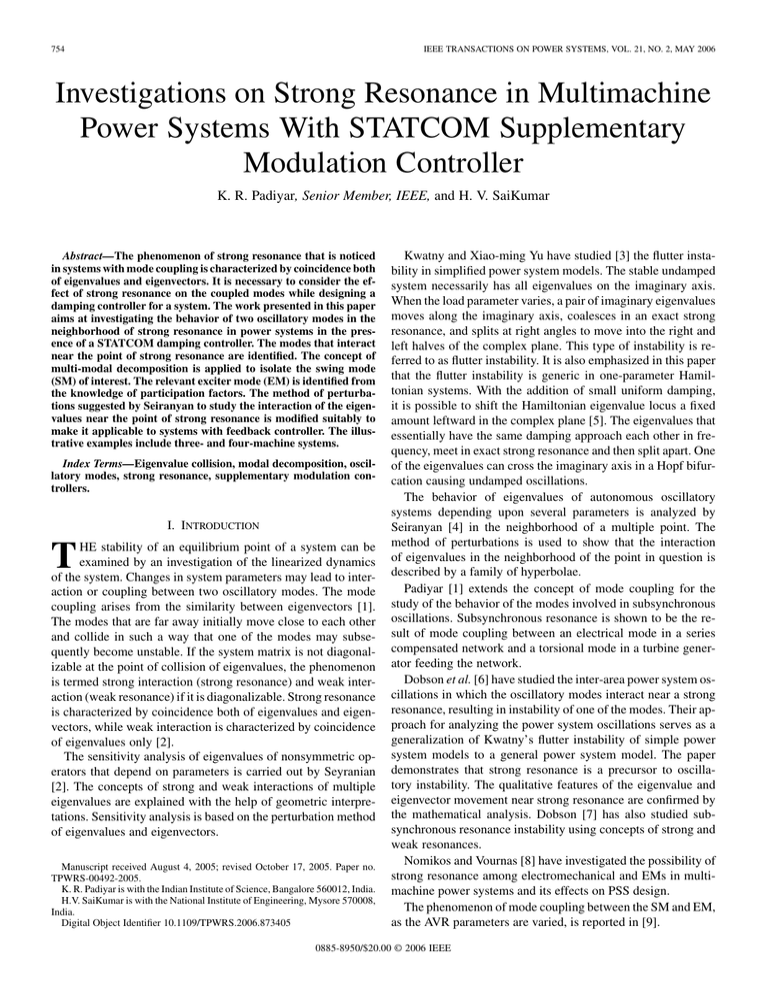
754 IEEE TRANSACTIONS ON POWER SYSTEMS, VOL. 21, NO. 2, MAY 2006 Investigations on Strong Resonance in Multimachine Power Systems With STATCOM Supplementary Modulation Controller K. R. Padiyar, Senior Member, IEEE, and H. V. SaiKumar Abstract—The phenomenon of strong resonance that is noticed in systems with mode coupling is characterized by coincidence both of eigenvalues and eigenvectors. It is necessary to consider the effect of strong resonance on the coupled modes while designing a damping controller for a system. The work presented in this paper aims at investigating the behavior of two oscillatory modes in the neighborhood of strong resonance in power systems in the presence of a STATCOM damping controller. The modes that interact near the point of strong resonance are identified. The concept of multi-modal decomposition is applied to isolate the swing mode (SM) of interest. The relevant exciter mode (EM) is identified from the knowledge of participation factors. The method of perturbations suggested by Seiranyan to study the interaction of the eigenvalues near the point of strong resonance is modified suitably to make it applicable to systems with feedback controller. The illustrative examples include three- and four-machine systems. Index Terms—Eigenvalue collision, modal decomposition, oscillatory modes, strong resonance, supplementary modulation controllers. I. INTRODUCTION T HE stability of an equilibrium point of a system can be examined by an investigation of the linearized dynamics of the system. Changes in system parameters may lead to interaction or coupling between two oscillatory modes. The mode coupling arises from the similarity between eigenvectors [1]. The modes that are far away initially move close to each other and collide in such a way that one of the modes may subsequently become unstable. If the system matrix is not diagonalizable at the point of collision of eigenvalues, the phenomenon is termed strong interaction (strong resonance) and weak interaction (weak resonance) if it is diagonalizable. Strong resonance is characterized by coincidence both of eigenvalues and eigenvectors, while weak interaction is characterized by coincidence of eigenvalues only [2]. The sensitivity analysis of eigenvalues of nonsymmetric operators that depend on parameters is carried out by Seyranian [2]. The concepts of strong and weak interactions of multiple eigenvalues are explained with the help of geometric interpretations. Sensitivity analysis is based on the perturbation method of eigenvalues and eigenvectors. Manuscript received August 4, 2005; revised October 17, 2005. Paper no. TPWRS-00492-2005. K. R. Padiyar is with the Indian Institute of Science, Bangalore 560012, India. H.V. SaiKumar is with the National Institute of Engineering, Mysore 570008, India. Digital Object Identifier 10.1109/TPWRS.2006.873405 Kwatny and Xiao-ming Yu have studied [3] the flutter instability in simplified power system models. The stable undamped system necessarily has all eigenvalues on the imaginary axis. When the load parameter varies, a pair of imaginary eigenvalues moves along the imaginary axis, coalesces in an exact strong resonance, and splits at right angles to move into the right and left halves of the complex plane. This type of instability is referred to as flutter instability. It is also emphasized in this paper that the flutter instability is generic in one-parameter Hamiltonian systems. With the addition of small uniform damping, it is possible to shift the Hamiltonian eigenvalue locus a fixed amount leftward in the complex plane [5]. The eigenvalues that essentially have the same damping approach each other in frequency, meet in exact strong resonance and then split apart. One of the eigenvalues can cross the imaginary axis in a Hopf bifurcation causing undamped oscillations. The behavior of eigenvalues of autonomous oscillatory systems depending upon several parameters is analyzed by Seiranyan [4] in the neighborhood of a multiple point. The method of perturbations is used to show that the interaction of eigenvalues in the neighborhood of the point in question is described by a family of hyperbolae. Padiyar [1] extends the concept of mode coupling for the study of the behavior of the modes involved in subsynchronous oscillations. Subsynchronous resonance is shown to be the result of mode coupling between an electrical mode in a series compensated network and a torsional mode in a turbine generator feeding the network. Dobson et al. [6] have studied the inter-area power system oscillations in which the oscillatory modes interact near a strong resonance, resulting in instability of one of the modes. Their approach for analyzing the power system oscillations serves as a generalization of Kwatny’s flutter instability of simple power system models to a general power system model. The paper demonstrates that strong resonance is a precursor to oscillatory instability. The qualitative features of the eigenvalue and eigenvector movement near strong resonance are confirmed by the mathematical analysis. Dobson [7] has also studied subsynchronous resonance instability using concepts of strong and weak resonances. Nomikos and Vournas [8] have investigated the possibility of strong resonance among electromechanical and EMs in multimachine power systems and its effects on PSS design. The phenomenon of mode coupling between the SM and EM, as the AVR parameters are varied, is reported in [9]. 0885-8950/$20.00 © 2006 IEEE PADIYAR AND SAIKUMAR: INVESTIGATIONS ON STRONG RESONANCE Padiyar and SaiKumar [10], [11] have considered the simplest possible power system model for studying the interaction between an SM and an EM. The dynamics of the SMIB system (with one-axis model generator and a static exciter with a single time constant AVR [12]) is represented by a fourth-order model. The strong resonance, which is due to the interaction between the EM and the SM, is caused by variations in the generator terminal voltage and the generator power dispatch. The exact location of strong resonance as a function of the two parameters is easily determined. Ian Dobson and Barocio [13] have analyzed general perturbations of a weak resonance and outlined two distinct behaviors, including interactions near strong resonance. In the present paper, the analysis of strong resonance (caused by interaction of an SM and an EM) due to the variation of controller parameters associated with a STATCOM supplementary modulation controller (SMC) has been investigated for the first time. The work reported in [6] has been extended by identifying the modes (an SM and an EM) responsible for strong resonance. The SM that interacts with the EM is isolated by the application of multi-modal decomposition concept, and the EM is identified by computing participation factors. The asymptotic behavior of the two modes in the neighborhood of strong resonance is investigated by extending the theory suggested by Seiranyan [4] and compared with the root loci of the systems with a STATCOM and its SMC. II. CONCEPT OF STRONG RESONANCE The strong resonance can be thought of as the result of coupling between two oscillatory modes. The mode coupling arises from the similarity between eigenvectors. It is commonly observed that when there is mode coupling, the change in the damping of one mode is opposite in sign to the change in the damping of the other coupled mode when an important parameter is varied. For example, in subsynchronous resonance (SSR) analysis, when there is increase in the series compensation level, the damping of the network mode is increased while the torsional mode (with which it is coupled) is negatively damped and vice versa. The degree of mode coupling varies with the level of compensation [1]. At a strong resonance, two complex pairs of eigenvalues coincide both in frequency and damping. Thus, the modes that are far away initially move close to each other and collide when at least two independent parameters vary. The collision of modes may subsequently result in the instability of one of the modes. Strong resonance does not normally occur when only one parameter is varied, but it is possible to pass near to strong resonance while varying one parameter. In practice, a power system will not experience exact strong resonance but will pass closer to strong resonance. When the system is near strong resonance, the eigenvalues and eigenvectors are very sensitive to parameter changes, and a parameter variation causes the eigenvalues to move quickly and turn through approximately 90 degrees in the complex plane [6]. The eigenvalue movements near resonance can be shown to be hyperbolas and a procedure for calculating the hyperbolas from the eigenstructure is given by Seyranian [4]. 755 III. SUPPLEMENTARY MODULATION CONTROLLER FOR STATCOM The block diagram of the supplementary modulation controller for STATCOM [14] considered in the work presented in this paper is shown in Fig. 1. The control signal used is known as Thevenin voltage and is synthesized from the locally measurable signal viz., the magnitude of the voltage of the bus at which the controller is connected and the output of STATCOM (i.e., the magnitude of the reactive current injected into the system). and are both tunable, and is The controller gains is the output of the the STATCOM plant time constant. STATCOM current controller, whose reference can be set by a voltage regulator (not considered here). In this paper, the fast dynamics of the current controller is neglected for convenience, is assumed to be zero. The controller is installed on the and STATCOM to enhance the damping of critical modes. The transfer function of the STATCOM with its supplementary modulation controller is (1) where is the magnitude of the voltage of the bus at which the the magnitude of the reactive STATCOM is connected and current injected by the STATCOM into the system. IV. MULTI-MODAL DECOMPOSITION AND DERIVATION OF THE REDUCED MODEL In the case of multimachine systems, the SM that interacts with the EM near the point of strong resonance is isolated by applying the concept of multi-modal decomposition [15]. Consider a multimachine power system, with synchronous machines represented by two-axis model (neglecting prime-mover dynamics) and the excitation system represented by a single time-constant system. For the equations describing the machine model, refer to [16]. The linearized model of the system can be represented in the state–space form as (2) and (3) where is a vector of state variables, and and are the input and output variables of the system, respectively. Equations (2) and (3) with subscript for the matrices represent the full system. Note that and are scalars. Let the states in equations (2) and (3) be arranged as , where ’s and the ’s represent the generator angles and is the vector of all the other state slips, respectively, and variables, and is the number of machines in the system. transformation For modal transformation, define an matrix such that , where (4) 756 IEEE TRANSACTIONS ON POWER SYSTEMS, VOL. 21, NO. 2, MAY 2006 Fig. 1. Block diagram of the supplementary modulation controller for the STATCOM. and the matrix is the matrix of the right eigenvectors such that , where is the sub matrix of of relating the generator angles to the derivative of speeds, and is a diagonal matrix. The transformation applied to the system represented by the equations (2) and (3) results in (5) (6) The angles and slips in the transformed system represent the modal variables, and the state matrix after transformation is (7) The modal frequencies can be approximately computed from the equation rad/sec, where are the diagonal elements of the matrix . After identifying the modes of interest, say, the th SM and the EM corresponding to th generator, arrange the state variand the modal slip ables such that the modal angle become the first and the second variables. and , where is the generator to which the EM belongs, are taken as the third and fourth variables of the subsystem. The generator with which the EM is associated is determined by computing participation factors. Thus, the reduced system consisting of only the modes that contribute to strong resonance can be represented by the state equations and the output equation as (8) and Fig. 2. Block diagram of reduced system with STATCOM damping controller. and the STATCOM supplementary modulation controller. Fig. 2 shows the block diagram of the reduced system (which is equivalent to an SMIB system). In the figure, the subscripts and are dropped for simplicity. is the modal inertia at the th generator corresponding to th mode modal damping associated with the th mode; direct axis open circuit transient time constant; automatic voltage regulator gain; exciter time constant; output of the STATCOM damping controller (see Fig. 1). to can be obFrom the Heffron–Phillips constants, tained as follows [16]: where is the th element of . , Also the gains can be expressed in terms of the elements of as follows:- , and matrix (9) where and angle corresponding to the th SM; slip of the th SM; quadrature axis voltage of the th generator; field voltage of the th generator. where . It is possible to describe the system shown in Fig. 2 by the following equation: V. SINGLE-MACHINE EQUIVALENT OF THE REDUCED MODEL The analysis of the behavior of a pair of oscillatory modes in the neighborhood of strong resonance is based on a reduced system (fifth-order system) retaining only the modes of interest (10) where , . The matrices are defined in Appendix A. and , , , , PADIYAR AND SAIKUMAR: INVESTIGATIONS ON STRONG RESONANCE 757 PARTICIPATION TABLE I STATE VARIABLES IN THE EM VALUES OF CONTROLLER GAIN OF FOR DIFFERENT Fig. 3. Three-machine system. Fig. 4. Root loci showing interaction of two complex modes in three-machine is increasing. system when K VI. APPLICATION EXAMPLES A. Three-Machine System A three-machine system (shown in Fig. 3) is considered for the analysis of the behavior of the modes interacting in the neighborhood of the point of strong resonance. The system considered is the same as that in [17], except that a bus (10) is created at the midpoint of line 7–5. A simple static exciter with and is considered on all generators (of two-axis model), and a fixed shunt capacitor of susceptance 0.5 at bus 5 is connected to provide voltage support. The loads are of constant power type. A STATCOM with its supplementary modulation controller is connected at bus 9 close to generator 3. The operating value of the output of the STATCOM is assumed to be zero. While tuning the controller at the given operating point to enhance the (with a fixed value of damping of SMs by varying the gain ), it was noticed [18] that there is an interaction (as shown in the Fig. 4) between an EM and the SM of frequency 13.109 rad/sec. The two modes move toward each other and coalesce when in an exact strong resonance at and . Fig. 5. Asymptotic behavior of eigenvalues of reduced system when increasing. K is In a system, there can be as many EMs as the number of generators. Hence, each EM can be associated with one of the generators in the system. The EM interacting with the SM is identified by computing the participation (factors) of various state variables in the mode of interest. The participation factors (absolute value) are computed for different values of the STATCOM and tabulated in Table I. The pardamping controller gain ticipation factors are computed for different values of the controller gain to examine whether there is any change (relative) in the contribution of various variables to a particular mode with the change in gain. It is observed from Table I that the participation of variables and of generator 3 in the EM (which is interacting with the SM) is greater than that of the other variables. Thus, this EM can be associated with generator 3. It is interesting to note that the EM, pertaining to the generator close to the bus at which the damping controller is connected, interacts with an SM, leading to the strong resonance phenomenon. The investigation of the behavior of the EM-SM pair near strong resonance is accomplished by the application of the method of perturbations [4], the theory of which is given in Appendix B. The strong resonance occurs for the reduced and . These values are system at different from the values observed for the full system due to 758 Fig. 6. Asymptotic behavior of eigenvalues of reduced system when increasing. IEEE TRANSACTIONS ON POWER SYSTEMS, VOL. 21, NO. 2, MAY 2006 X is the approximations involved in the system reduction. Figs. 5 and 6 illustrate the asymptotic behavior of the eigenvalues of interest in the neighborhood of the point of strong resonance for fixed values ( 1.1131,13.129) due to the change in 1) , and 2) for fixed values of , respectively. The of magnitude of perturbations effected in and is 0.0001. It is observed from Fig. 5, that the eigenvalue associated with , moves toward the right after passing the EM, when is varied. This also results in the near strong resonance, as , the increase in the damping of the SM. When eigenvalue associated with the SM moves toward the right after passing near strong resonance. Thus, the damping of one of the modes increases, while that of the other decreases due to strong resonance. Thus the phenomenon of strong resonance can lead to instability of one of the modes. causes From Fig. 6, it is observed that increase in the eigenvalues associated with the two modes to change in damping, with negligible change in frequency before resonance. After the resonance, the increase in the parameter brings about a change in frequency, with almost no change in damping. Thus, the phenomenon of strong resonance in this case limits the damping of the modes interacting near the multiple point. On the other hand, when the eigenvalues are located in the vicinity of the multiple point, if one attempts , the eigenvalues pertaining to the two modes to decrease move in opposite directions, resulting in the crossing over of could the SM into the right half plane. Thus, the decreasing lead to destabilization of the system due to strong resonance. However, in both cases, it is observed that an infinitesimal or ) results in a drastic change in one of the parameters ( change in the behavior of the two modes. For comparison, the loci of eigenvalues associated with the SM and the EM (involved in strong resonance) of the full and reduced systems, when the controller parameters are increased (only two cases are shown), are illustrated in Figs. 7–10 (the and is 0.0001). magnitude of perturbations effected in It is observed from these figures that the qualitative behavior of the coupled modes (in the complete system) in the neighborhood of strong resonance is identical to that in the case of reduced system, though there are small differences in the numerical values of the multiple point, root loci directions, and Fig. 7. Root loci of three-machine system when is positive. Fig. 8. Root loci of reduced system when positive. K Fig. 9. Root loci of three-machine system when is positive. K is increasing when is increasing when X 1X 1X is increasing when is 1K controller parameters at strong resonance. This observation thus justifies the application of the reduced model of the system for the analysis of strong resonance. It is interesting to observe (from Figs. 5, 7, and 8) that as is increased (for ), the frequency of the EM reaches a PADIYAR AND SAIKUMAR: INVESTIGATIONS ON STRONG RESONANCE Fig. 10. Root loci of reduced system when positive. Fig. 11. X is increasing when 1K 759 is Fig. 12. Asymptotic behavior of eigenvalues of reduced system when increasing. K is Four-machine system. minimum and that of the SM reaches a maximum in the neighborhood of the strong resonance. However, the damping of the SM continues to increase while that of the EM continues to deis increased (for crease. On the other hand, when ), the damping of the SM reaches a maximum, while that of the EM reaches a minimum in the neighborhood of the strong resonance. The frequency of EM reduces sharply, while the frequency of the SM increases sharply after crossing the strong resonance. B. Four-Machine, Two-Area System A four-machine, ten-bus system (shown in Fig. 11) that consists of two areas connected by three ac tie lines is considered to analyze the behavior of the inter-area mode and an EM in the neighborhood of strong resonance. The study system is the same as that in [16] and [19], except that the damping of all the generators is uniformly taken as 1.0 p.u. (instead of zero), and the armature resistance is neglected. The generators are represented by a two-axis model, and the loads are modeled as constant impedances. A STATCOM with its supplementary modulation controller is connected at bus 111 (in area 2). The operating value of the output of the STATCOM is assumed to be zero. While tuning the controller at the given operating point to enhance the damping (with a fixed value of ), it of SMs by varying the gain was noticed [18] that there is an interaction between an EM and the inter-area mode of frequency 4.4445 rad/sec. It was possible to get exact strong resonance (figure is not shown) by tuning the Fig. 13. Asymptotic behavior of eigenvalues of reduced system when increasing. X is control parameters. The two modes move toward each other and coalesce in an exact strong resonance at when and . By computing participation factors (not shown) for different values of the STATCOM damping controller gain , it is found that the EM associated with the generator connected to bus 11 is interacting with the low-frequency inter-area SM near strong resonance. Figs. 12 and 13 illustrate the asymptotic behavior of the eigenvalues of interest in the neighborhood of the point of strong resonance ( 0.349 31,3.8257) due to the increase in for fixed values of , and 2) for fixed values of 1) , respectively. It is to be noted that strong resonance occurs and for the reduced system. for Also the magnitude of perturbations effected in is 0.1 and is 0.0001. that in is increased, keeping constant (refer to When Fig. 12), the eigenvalues change in damping before resonance and change in frequency after resonance, thus limiting the damping of modes. From Fig. 13, it is observed that when is increased with , the damping of the SM increases is increased and that of the EM reduces. However, when with , the damping of SM increases before resonance and decreases after resonance, while that of the EM decreases before resonance and increases after resonance. 760 IEEE TRANSACTIONS ON POWER SYSTEMS, VOL. 21, NO. 2, MAY 2006 VII. DISCUSSION Although the analysis in a multimachine system is based on the reduced model retaining only the two modes of interest and the controller, the results obtained from the analysis are accurate enough to predict the behavior of eigenvalues in the neighborhood of strong resonance for the detailed system. is increased, the It is observed from Figs. 5 and 12 that as eigenvalues associated with both the SM and the EM turn by 90 or at strong resonance, depending on whether or . On the other hand, as is increased, the or , if , at eigenvalues turn by 90 if strong resonance (see Figs. 6 and 13). Although the orientation of the axes of the hyperbola can vary depending on the system considered, the eigenvalue movements are qualitatively similar in both cases. A damping controller designed to damp low-frequency oscillations by considering only a critical mode may not be effective when there is modal interaction near a strong resonance. This is because when there is mode coupling, an attempt to increase the damping of a poorly damped mode results in a simultaneous reduction in the damping of the second mode. Thus, it is important to consider the effect of strong resonance on the coupled modes while designing a damping controller for the system. The implications of modal interaction and resonance on PSS design are described in [8]. Broadly, it can be said that the optimal tuning (with the objective of maximizing the damping of the critical mode) requires the choice of control parameters in the neighborhood of strong resonance (see Figs. 7 and 9). If the location of a strong resonance is close to the imaginary axis, it can limit the damping of the critical SM. Thus, the strong resonance can impact the effectiveness of the controller. The results presented in this paper indicate the similarity of a STATCOM SMC with a PSS. In both cases, there can be modal resonance involving an SM and an EM, which affects the tuning of the controller parameters. The analysis of a strong resonance due to a STATCOM SMC in multimachine power systems is facilitated by the system reduction that retains the identity of the two modes of interest. The results from the analysis of the reduced system enable the location of the strong resonance point in the full system. They also predict the movements of the eigenvalues in the neighborhood of the strong resonance as the control parameters are varied. VIII. CONCLUSION The analysis of strong resonance (caused by interaction of an SM and an EM) due to the variation of controller parameters associated with a STATCOM supplementary modulation controller has been investigated for the first time. This is an extension of the work reported in [6] and [8]. The SM that interacts with the EM is isolated by the application of multimodal decomposition concept, and the EM is identified by computing participation factors. The theory suggested by Seiranyan to study the interaction of the eigenvalues near the multiple point is modified suitably to make it applicable to systems with feedback controller. The asymptotic behavior of the two modes in the neighborhood of strong resonance is investigated using the reduced system model and compared with the root loci of the system (both reduced and original). APPENDIX A MATRICES OF VECTOR DIFFERENTIAL EQUATION (10) where rad/sec. , and is the system frequency in APPENDIX B BACKGROUND THEORY The reduced system [represented by (8) and (9)] with STATCOM and its damping controller is expressed by a vector differential equation (10) in Section V. The output (9) of the system with the STATCOM damping controller can also be written as (11) where . It is to be noted that and is the th element of . Equation (1) gives the mathematical model of the STATCOM damping controller. From this equation, we have (12) Substituting (12) in (11), it is easy to obtain an equation relating and as (13) where (14) Substitution of (13) in (10) gives (15) where and . PADIYAR AND SAIKUMAR: INVESTIGATIONS ON STRONG RESONANCE 761 It is to be noted that the theory developed by Seiranyan [4] assumes autonomous systems, depending on several parameters, and the dynamics of a linear oscillatory system are described by a vector-matrix differential equation. In the work presented in this paper also, the system and the controller dynamics are represented by an autonomous vector-matrix differential equation, as given in (15). , , , and are funcThe elements of the matrices . tions of the components of the parameter vector in this In general, can have components, although case. Let the parameter vector corresponding to a double root of the characteristic equation be . The corresponding eigenvector , the associated eigenvector , and the adjoint eigenvector are determined, respectively, from the equations (16) (17) To investigate the behavior of the eigenvalues in the complex -plane, the increment in the eigenvalue is written in terms of the real and imaginary parts as (25) Using (25) and squaring (24) (26) (27) Eliminating one of the parameters, say, , from (26) and (27), the equation for the hyperbola with mutually orthogonal asympcan be written as totes constant (18) (28) where where (29) (19) is the conjugate transpose of the matrix ) and , , , and . To investigate the behavior of the eigenvalues in the neighborhood of the point in the parameter is given an increment , where space, the vector is an arbitrary normalized variation vector , and is a small such that parameter, . As a result of perturbation in , the matrices , , , and also receive increments. The expansion [2] for is given by ( (20) where is the first correction given by (21) where (22) and (23) Let real and imag plying by can be written as . Then, (21) after multi- (24) It is assumed that only the first parameter is varied and the others are held constants. Thus, (28) represents the asymptotic movement of the two oscillatory modes as varies. REFERENCES [1] K. R. Padiyar, Analysis of Subsynchronous Resonance in Power Systems. Norwell, MA: Kluwer, 1999. [2] A. P. Seyranian, “Sensitivity analysis of multiple eigenvalues,” Mech. Struct. Mach., vol. 21, no. 2, pp. 261–284, 1993. [3] H. G. Kwatny and X.-M. Yu, “Energy analysis of load-induced flutter instability in classical models of electric power networks,” IEEE Trans. Circuits Syst., vol. 36, no. 12, pp. 1544–1557, Dec. 1989. [4] A. P. Seiranyan, “Collision of eigenvalues in linear oscillatory systems,” J. Appl. Math. Mech., vol. 58, no. 5, pp. 805–813, 1994. [5] H. G. Kwatny and G. E. Piper, “Frequency domain analysis of Hopf bifurcations in electric power networks,” IEEE Trans. Circuits Syst., vol. 37, no. 10, pp. 1317–1321, Oct. 1990. [6] I. Dobson, J. Zhang, S. Greene, H. Engdahl, and P. W. Sauer, “Is strong resonance a precursor to power system oscillations?,” IEEE Trans. Circuits Syst. I, Fundam. Theory Appl., vol. 48, no. 3, pp. 340–349, Mar. 2001. [7] I. Dobson, “Strong resonance effects in normal form analysis and subsynchronous resonance,” in Proc. Bulk Power System Dynamics Control V, Onomichi, Japan, Aug. 26–31, 2001. [8] B. M. Nomikos and C. D. Vournas, “Modal interaction and PSS design,” in Proc. IEEE Power Tech Conf., Porto, Portugal, Sep. 10–13, 2001. [9] K. R. Padiyar and K. Bhaskar, “An integrated analysis of voltage and angle stability of a three node power system,” Elect. Power Energy Syst., vol. 24, pp. 489–501, 2002. [10] K. R. Padiyar and H. V. SaiKumar, “Analysis of strong resonance in power systems with STATCOM supplementary modulation controllers,” in Proc. IEEE TENCON, Bangalore, India, Oct. 15–17, 2003. [11] H. V. SaiKumar, “Investigations on small signal stability of power systems affected by FACTS supplementary modulation controllers,” Ph.D. dissertation, Dept. Elect. Eng., Indian Inst. Science, Bangalore, India, 2004. [12] F. P. Demello and C. Concordia, “Concepts of synchronous machine stability as affected by excitation control,” IEEE Trans. Power App. Syst., vol. PAS-88, no. 4, pp. 316–329, Apr. 1969. [13] I. Dobson and E. Barocio, “Perturbations of weakly resonant power system electromechanical modes,” IEEE Trans. Power Syst., vol. 20, no. 1, pp. 330–337, Feb. 2005. 762 [14] A. M. Kulkarni and K. R. Padiyar, “Damping of power swings using shunt FACTS controllers,” in Proc. Fourth Workshop EHV Technology, Bangalore, India, Jul. 1998. [15] E. V. Larsen, J. J. Sanchez-Gasca, and J. H. Chow, “Concepts for design of FACTS controllers to damp power swings,” IEEE Trans. Power Syst., vol. 10, no. 2, pp. 948–956, May 1995. [16] K. R. Padiyar, Power System Dynamics—Stability and Control, 2nd ed. Hyderabad, India: BS Publications, 2002. [17] P. M. Anderson and A. A. Fouad, Power System Control and Stability. Ames, IA: Iowa State Univ. Press, 1977. [18] K. R. Padiyar and V. Swayam Prakash, “Tuning and performance evaluation of damping controller for a STATCOM,” Elect. Power Energy Syst., vol. 25, pp. 155–156, 2003. [19] M. Klein, G. J. Rogers, and P. Kundur, “A fundamental study of interarea oscillations in power systems,” IEEE Trans. Power Syst., vol. 6, no. 3, pp. 914–921, Aug. 1991. IEEE TRANSACTIONS ON POWER SYSTEMS, VOL. 21, NO. 2, MAY 2006 K. R. Padiyar (SM’91) received the B.E. degree in electrical engineering from Poona University, Poona, India, in 1962, the M.E. degree from the Indian Institute of Science, Bangalore, India, in 1964, and the Ph.D. degree from the University of Waterloo, Waterloo, ON, Canada, in 1972. Currently, he is an Honorary Professor of electrical engineering at the Indian Institute of Science. He was with Indian Institute of Technology, Kanpur, India, from 1976–1987 prior to joining the Indian Institute of Science. His research interests are in the areas of HVDC and FACTS, system dynamics, and control. He has authored four books and over 200 papers. Dr. Padiyar is a Fellow of the National Academy of Engineering (India). H. V. SaiKumar received the B.E. degree in electrical engineering from Mysore University, Mysore, India, in 1981, the M.Tech. degree from the Indian Institute of Technology, Madras, India, in 1987, and the Ph.D. degree from the Indian Institute of Science, Bangalore, India, in 2005. Currently, he is an Assistant Professor of electrical and electronics engineering at the National Institute of Engineering, Mysore, India. His research interests are in the areas of FACTS, system dynamics, and control.

